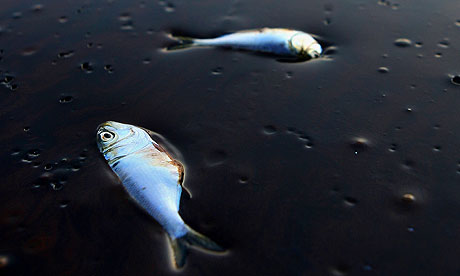
Scientists are confronting growing evidence that BP's ruptured well in the Gulf of Mexico is creating oxygen-depleted "dead zones" where fish and other marine life cannot survive.
In two separate research voyages, independent scientists have detected what were described as "astonishingly high" levels of methane, or natural gas, bubbling from the well site, setting off a chain of reactions that suck the oxygen out of the water. In some cases, methane concentrations are 100,000 times normal levels.
Other scientists as well as sport fishermen are reporting unusual movements of fish, shrimp, crab and other marine life, including increased shark sightings closer to the Alabama coast.
Larry Crowder, a marine biologist at Duke University, said there were already signs that fish were being driven from their habitat.
"The animals are already voting with their fins to get away from where the oil spill is and where potentially there is oxygen depletion," he said. "When you begin to see animals changing their distribution that is telling you about the quality of water further offshore. Basically, the fish are moving closer to shore to try to get to better water."
Such sightings - and an accumulation of data from the site of the ruptured well and from the ocean depths miles away - have deepened concerns that the enormity of the environmental disaster in the Gulf has yet to be fully understood. It could also jeopardise the Gulf's billion-dollar fishing and shrimping industry.
In a conference call with reporters, Samantha Joye, a scientist at the University of Georgia who has been studying the effects of the spill at depth, said the ruptured well was producing up to 50% as much methane and other gases as oil.
The finding presents a new challenge to scientists who so far have been focused on studying the effects on the Gulf of crude oil, and the 5.7m litres of chemical dispersants used to break up the slick.
Joye said her preliminary findings suggested the high volume of methane coming out of the well could upset the ocean food chain. Such high concentrations, it is feared, would trigger the growth of microbes, which break up the methane, but also gobble up oxygen needed by marine life to survive, driving out other living things.
Joye said the methane was settling in a 200-metre layer of the water column, between depths of 1,000 to 1,300 metres in concentrations that were already threatening oxygen levels.
"That water can go completely anoxic [extremely low oxygen] and that is a pretty serious situation for any oxygen-requiring organism. We haven't seen zero-oxygen water but there is certainly enough gas in the water to draw oxygen down to zero," she said.
"It could wreak havoc with those communities that require oxygen," Joye said, wiping out plankton and other organisms at the bottom of the food chain.
A Texas A&M University oceanographer issued a similar warning last week on his return from a 10-day research voyage in the Gulf. John Kessler recorded "astonishingly high" methane levels in surface and deep water within a five-mile radius of the ruptured well. His team also recorded 30% depletion of oxygen in some locations.
Even without the gusher, the Gulf was afflicted by 6,000 to 7,000 square miles of dead zone at the mouth of the Mississippi river, caused by run-off from animal waste and farm fertiliser.
The run-off sets off a chain reaction. Algae bloom and quickly die, and are eaten up by microbes that also consume oxygen needed by marine life.
But the huge quantities of methane, or natural gas, being released from the well in addition to crude presents an entirely new danger to marine life and to the Gulf's lucrative fishing and shrimping industry.
"Things are changing, and what impacts there are on the food web are not going to be clear until we go out and measure that," said Joye.



The Earths oceans are becoming nothing more than giant cesspools. The Gulf of Mexico is going to be one big dead zone soon if they don't stop this oil.